Deborah J. Ross's Blog, page 22
January 13, 2023
Short Book Reviews: A Woman Police Detective Across Dimensions
Marked, by S. Andrew Swann (DAW)
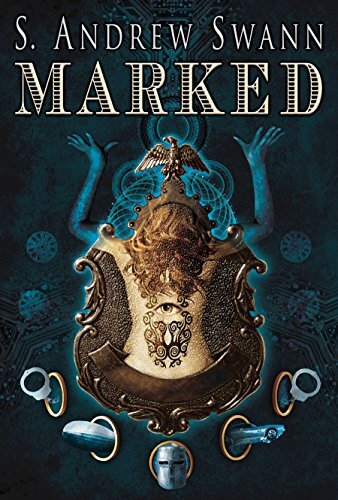
Reminiscent of Roger Zelazny’s Amber series, this “portal to another world” fantasy begins as a police procedural with a twist. Detective Dana Rohan’s life is filled with secrets. One is the intricate, tattoo-like Mark across her back that has grown in complexity and extent since the time she was found as an orphaned child. The other is what the Mark does. By an act of will, she can travel across time and alternate worlds. She’s been using this ability to solve crimes, at the risk of attracting the suspicions of the police higher-ups, even the distrust of her partner when she almost gets caught hiding a revolver used in a crime in a parallel world when one exists in police custody in this reality. Her problems quickly fade to insignificance when a series of bizarre encounters, including near-fatal assaults by zombie-like, cannibal “Shadows,” propel her from her ordinary life into a multitude of different realities. From formless, roiling Chaos to a world in which Napoleon III rules the Western World, her only hope of survival is turning the tables on the culprit behind the assaults.
I’m a fan of stories that start in the everyday world, often with a character with a mysterious past, and end up in increasingly more fantastic settings. I mentioned Zelazny’s Amber series, also Anne McCaffrey’s Restoree, and let’s not forget all the magical-door stories like C. S. Lewis’s Narnia. This one has the added features of a woman detective who is more than capable of defending herself, a slow-simmer romance, and the usual quirks of alternate histories. It’s fast-paced and full of plot twists and drama. All in all, a quick but satisfying read.
January 9, 2023
Auntie Deborah's New Writing Advice
It's a new year, and aspiring writers have questions!

Q: Dear Auntie Deborah, I just got the rights for my novel back from my now-defunct publisher. Will I be able to sell it to another publisher?
A: It’s a wretched situation and I’m so sorry you find yourself in it. If it helps, you’re not alone. Not only are publishers going under but mergers are resulting in the cancellation of contracts for not-yet-delivered books, even for long-running series by established authors.
The short but brutal answer is, probably not. The exception might be if your book sold brilliantly, as in NYTimes Bestseller List, but even then it’s unlikely to attract interest because it’s “old news.” Publishers today are extremely conservative in the books they acquire; editors are reluctant to take chances; alas, your book now falls into the category of out-of-print/poor sales figures, regardless of whether it’s the fault of the book or not. The sales numbers might be low because the book was only available for two days, but that doesn’t matter. The other possibility is the few specialty small presses that occasionally acquire previously published books by authors with huge readerships, books that for one reason or another got dropped (as in your case, where the publisher ceased business). Your agent should be able to advise you whether this is a possibility for you.
Your best bet is to get a new, professionally designed cover and ISBN and self-publish the novel yourself. If you do this, I encourage you to go “wide,” that is, hit multiple vendors, not just Amazon Kindle. Draft 2 Digital will allow you to place a book in many markets, including those providing library loans, or you could do it individually. You could also put out an audio version of your book.
Q: Is it better to use names or numbers for chapter titles?
A: There is no “better.” There are conventions that change with time. Do what you love. Just as titles vs numbers cannot sell a book, neither will they sink a sale. If your editor or publisher has a house style, they’ll tell you and then you can argue with them.
That said, as a reader I love chapter titles. As an author, I sometimes come up with brilliant titles but I haven’t managed to do so for an entire novel, so I default to numbers. One of these years, I’ll ditch consistency and mix and match them. Won’t that be fun!
Q: Can I make changes to my self-published book once it's released?
A: Of course, you can. If they’re minor changes, like fixing typos, just upload the corrected file. If the changes are more substantial, like a revision, it’s best to indicate that so your readers don’t think it’s a different book. “Author’s Revised Edition” is one way of indicating this.
The same goes for changing cover art. Traditional publishers and indie authors do this all the time, as styles in cover art and design evolve. Just make it clear it’s a new cover, not a new book. Otoh, fanatical collectors of your work will grab the new-cover edition just to be complete.
Q: What's the best way to collaborate on a novel?
A: There is no best way, there’s only what works for you and your partner. One can draft and the other revise; you can alternate scenes or even chapters; one can dictate and the other edit while transcribing. Or whatever.
The hard and fast rule is: GET YOUR AGREEMENT IN WRITING, including how you will handle a break-up. Consider it an ironclad literary pre-nup. You will save yourselves a world of hurt if you rely on your memory of an oral agreement once money is involved.
January 6, 2023
Short Book Reviews: Tippecanoe and Murder, Too
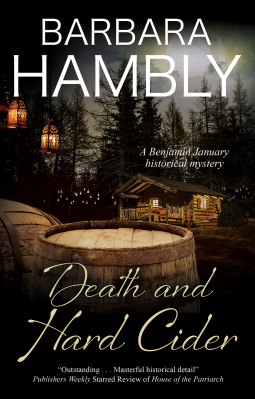 Death and Hard Cider, by Barbara Hambly (Severn House)
Death and Hard Cider, by Barbara Hambly (Severn House)When I open a Barbara Hambly novel, whether a 1920s Hollywood mystery, a fantasy-with-dragons, or a disturbingly dark vampire tale, I’m in for a treat. Hambly’s touch is deft, never overwrought, her knowledge of history and human nature unerring, and her characters, memorable. One of my favorites is Benjamin January, born a slave in early 19th Century Louisiana, freed and then educated as a surgeon (and musician) in Paris, now back in New Orleans. Over the course of the preceding volumes, he’s cobbled together a living as a musician playing at parties and other events by the rich whites of the city, while solving more mysteries than a raft of Sherlock Holmses, despite the intricate mores of the old French culture and the encroaching danger of the American way of slavery. He’s in constant danger of being kidnapped, his freedom papers destroyed, and being sold to a plantation and a short, brutal life in the sugar cane fields. Despite all this, he has married an extraordinary Black woman and made more than a few friends, some of them white. The one thing he’s never wanted to get involved with is American politics.
But it’s 1840 and William Henry Harrison is running for president. The campaign involves a monumental rally with speeches, fireworks, balls, and dinner parties, and Ben badly needs the meager pay in an otherwise dead season. In the midst of the campaign, a privileged young white woman, a determined flirt notorious for setting her suitors against each other, is found murdered. Suspicion lands, quite illogically, on a Black woman, Catherine, Ben’s dear friend and first, unrequited love.
As with previous Ben January mysteries, the fascinating historical detail, plot twists, engaging characters, and deeply felt but restrained emotion kept me turning the pages. This book continues the earlier focus on the precarious condition of Black people in pre-Civil War New Orleans. It seemed to me, however, that the contradictions, turmoil, and simmering anger of Ben and his community came to the fore more powerfully. Perhaps that is due to the countdown to the Civil War or the grinding decades of oppression and fear, the perpetual risk of enslavement and necessity of humbling himself before men who cannot compare with his education, culture, and achievements, let alone his intelligence and innate decency. These feelings are among the things Ben dares not share with his few white friends (the unwashed but shrewd sheriff, the ex-addict Latin-quoting violinist), yet are instantly understood by the entire Black community.
Like all of Hambly’s work, highly recommended.
January 3, 2023
Deborah's Winter Storm Check-In
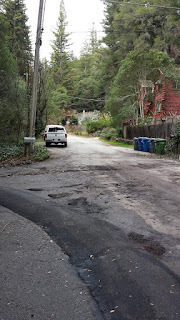 Asphalt berm. Rain runoff is right to left.
Asphalt berm. Rain runoff is right to left. Thank you, to all who reached out to me in the recent storm. My family and I are hunkered down, as usual for heavy winter rainfall. Neighbors keep us informed about local road closures.Yesterday and this morning were brief breaks in the atmospheric river. so mine beloved spouse and I checked out the state of debris from uphill and the various water diversion measures. We had worked with our neighbor (on the above-mentioned "uphill") on a culvert that runs under our tiny-but-paved street, then debouches (isn't that a wonderful word?) beside our carport and eventually the water runs along our property line and spreads out. The idea is that by this time, it's lost its momentum and can percolate into the ground, replenishing the water table. We also placed an asphalt berm to direct rain toward the stream instead of our garage and house.
Our biggest concern has been debris flows because this area, including "uphill," was burned during the 2020 wildfires. The burned areas are all nicely green, and the redwood trees have stabilized the slopes better than we hoped for. This is the third winter since the fires, so the increased risk (over normal conditions) is very small.
Every winter, slides close roads and downed trees knock out power lines. That's life in the mountains. We have a backup generator and I work at home, so we're relatively lightly impacted. The larder is full, we have plenty of books to read, and oh yes -- I have several to get back to writing!
Again, thanks for your caring, and may we all have a safe and happy coming year!
January 2, 2023
Revisiting Nightmares: Fantasy/Horror Crossovers and Trauma Recovery
 Nightmare by Abildgaard
Nightmare by AbildgaardFantasy and horror have a natural affinity, one that goes back to the pre-literate times when people sat around the campfire, terrifying each other with stories of ghosts and skin-walkers and things-that-go-bump-in-the-night or that-are-not-quite-dead. Supernatural elements infused these tales with delightful spine-tingling shivers. One might speculate that way back then, the entire world must have seemed a perilous place, filled with phenomena beyond human understanding. I think that does a discredit to peoples who might have a much lower level of technology than we do but were nonetheless extremely sophisticated in their conceptualization and emotional understanding of the world around them. For all our computers and skyscrapers, we are just as enthralled by the uncanny and that jolt of adrenaline. [image error] Nightmare by GauguinOf course, as individuals we vary in what is pleasurable to us. One person’s fun may be the trigger that causes months of terrifying nightmares for another person. This is especially true for people who have themselves been the victims of trauma, whether the assault has come in the form of physical violence or from psychological or emotional abuse. Reading horror or dark fantasy is not an approved method of psychotherapy, but encountering these stories mindfully can shift our perspective. Good fiction of any kind does not “stay on the page” but has the power to change the way we see ourselves and our lives. Horror, by its focus on frightening elements, carries a particular emotional punch.
Like so much genre literature today, the distinctions between fantasy and horror are often driven by the requirements of marketing, with blurry overlapping areas like dark fantasy. One might otherwise lump them all together as “literature of the macabre,” today’s incarnation of the 19thCentury Gothic novel. I doubt that Edgar Allan Poe would have thought of his work as either fantasy or horror, although he might have been quite delighted with macabre.
[image error] Horror, with the exception of purely psychological horror, represents a subset of fantasy. This subset is of course a spectrum, from fantasy with slightly “dark” aspects to horror that includes or relies upon fantastical elements. I would go even further in arguing that shadows –elements that partake of the spookier side of the supernatural, or inversions of everyday expectations – are what give good fantasy much of its appeal. For every Hobbiton, there is a Mordor, and not even Lothlorien with its Mirror of Galadriel is without danger. Shadows give shape to light, and risk heightens the value of the hero’s journey. After all, what is more dangerous and suspenseful than a journey into lands and times when the dead can walk (and wreak revenge), humans can take the form of animals (and vice versa), and malevolence is a real and present force.
Some stories have no point other than to horrify; they are unrelentingly gruesome and bleak. The portrayal of – adulation of -- futility against overwhelming evil is not limited to the horror genre. Existentialist despair, as well as depictions of the depth of human pain and the height of human malice, have their place in the canon of literature. Fiction allows us to view and explore frightening events and to grapple with appalling things in the company of trusted companions.
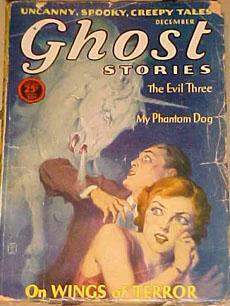 Horror not only delivers a certain emotional palette but a resolution that is satisfying for the neutral reader and can be helpful to the person wrestling with their own experience of fear. Here the overlap with fantasy plays a special role, for fantasy by its very nature alters the rules of ordinary reality. The “contract with the reader” includes the premise that impossible things can and will happen, both horrible and wonderful. Fantasy is also particularly suited to the use of symbol and archetype to deepen emotional resonances.
Horror not only delivers a certain emotional palette but a resolution that is satisfying for the neutral reader and can be helpful to the person wrestling with their own experience of fear. Here the overlap with fantasy plays a special role, for fantasy by its very nature alters the rules of ordinary reality. The “contract with the reader” includes the premise that impossible things can and will happen, both horrible and wonderful. Fantasy is also particularly suited to the use of symbol and archetype to deepen emotional resonances.Good fantasy, including good horror, has a moral compass. Just as mystery stories result in the re-establishment of order through the discovery of the wrong-doer and consequent victory of justice, so other genre forms have as their foundation a world that makes sense. Magic has its rules, price, and limitations. Horrendous things happen, but they do so for a reason and we as readers learn what that reason is.It may be an incomprehensible or superficial reason – because the Elder Gods are so alien that they drive men mad, or because the Duke of Darkness wants to rule the entire world, or simply because Lord Bad Guy gets up every morning and chants, Evil, evil rah rah rah – but the reason exists, and if we are willing to go along with the premises in this particular story, we will discover its underlying logical structure. This is where fiction and real life differ, because in real life, all too often we have no clue as to the motivation of the person who has harmed us, if indeed it is a person and not a force of nature, and if the person is known, or we are left with pieces of evidence and even more conjecture that we cannot assemble into any kind of rationale.
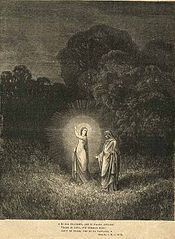 Dante and Beatrice by DoreI mentioned “trusted companions.” One of the most crippling things about personal trauma is the sense of isolation. Not only do we feel powerless, but all too often, our experience is that no one else can truly understand what it was like. In fiction, on the other hand, we are never alone. Even if the protagonist is isolated and has no allies, the two of you – reader and hero -- are in the adventure together. The hero discovers her own strengths, whether they be determination, courage or ingenuity, particular skills, or anything else. And she is not always cast solely on her own resources. Even if the “trusty sidekick” dies a horrible death before the end, for a time, the journey is shared and the hero can draw on the loyalty and abilities of her mentor, her friends, even the people who depend on her.
Dante and Beatrice by DoreI mentioned “trusted companions.” One of the most crippling things about personal trauma is the sense of isolation. Not only do we feel powerless, but all too often, our experience is that no one else can truly understand what it was like. In fiction, on the other hand, we are never alone. Even if the protagonist is isolated and has no allies, the two of you – reader and hero -- are in the adventure together. The hero discovers her own strengths, whether they be determination, courage or ingenuity, particular skills, or anything else. And she is not always cast solely on her own resources. Even if the “trusty sidekick” dies a horrible death before the end, for a time, the journey is shared and the hero can draw on the loyalty and abilities of her mentor, her friends, even the people who depend on her.We learn by role modeling, and as we journey with the hero through fear and peril, we see how one character manages to endure and even emerge stronger and more self-confident. All too often, trauma survivors feel not only powerless but incompetent, seeing only what they have not been able to prevent and not what has allowed them to survive. It’s easier to see our strengths as well as our failures in another person, or in this case, another character.
Fantasy comes in shades of frightfulness, everything from sweetness-and-light unicorns to the overwhelmingly gruesome. The reader – forearmed with a certain amount of information about any given story – has the ability to control how dark and terrifying the territory they venture into. The lingering effects of a personal experience of trauma or abuse involve the past loss of power and the fear that nothing we can do will prevent it from happening again. Navigating the borders between fantasy and dark fantasy, and dark fantasy and horror, allow us to decide what is pleasurably shocking versus what is beyond our present ability to tolerate, as well as how far and at what pace we want to proceed. What is overwhelming at one time in a person’s recovery may at some later point become the landscape for facing previously unimaginable fears. Depictions of violence (particularly in video games) have often been accused of promoting these very behaviors, although the exact opposite argument might be made. However, in the case of a trauma survivor, horror and dark fantasy can serve as a means of desensitization, of diminishing the paralyzing effects of the real-life event. Because horror and fantasy are part of a spectrum, we have the power to begin within our comfort range and venture forth in incremental stages, only as far and as fast as we choose.
It can be said of both fantasy and horror that they function on different levels of the human psyche. Perhaps the most superficial is their quality as literature, and like any other genre, this varies from superb to abysmal. However, both tap into the imagination and deep emotions – it might be said of horror that this is its purpose – in ways that give them value apart from purely literary considerations. People read both for a variety of reasons – escapism, intellectual stimulation, entertainment, wonder, an emotional joyride – but these genres are also journeys through our own inner landscapes. The crossover borderlands invite us into the territory of our fears.
December 30, 2022
Short Book Reviews: "This Fine Crew" of Weird and Wonderful Aliens
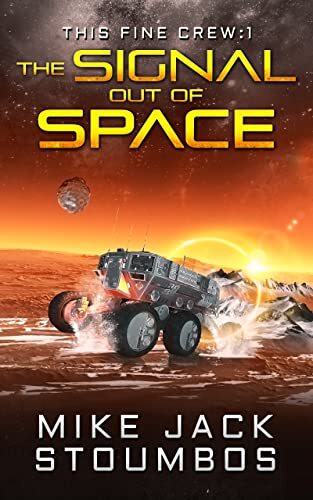 The Signal out of Space, by Mike Jack Stoumbos (Theogony Books)
The Signal out of Space, by Mike Jack Stoumbos (Theogony Books) This space opera hits so many tropes just right! It’s a school story (well, cadets in the Interstellar Initiative, but close enough), a patchwork of alien species learning to work together (shades of Star Trek) and a mystery. After a brutal interspecies war, the Interstellar Initiative is the galaxy’s best hope for peace, cooperation, and rewriting nasty first impressions.
To begin with, our motley crew includes: A declawed reptilian engineer who goes “Mmmmmm!”A furry medic with a secret noble heritage, like a werewolf with tusksAn insectoid programmed to adore humans, whose chosen name is Paul Newman and who has four arms, rather than wingsA barely-legal-age human pilot who reminds me of the kid in the film, The Last Starfighter with his gift with video games and puppy-like enthusiasm.The prolog throws us into action as the crew hurtles across the Martian terrain in a test run when matters go seriously pear-shaped. It’s confusing because (a) there’s no context for any of these characters or their relationships (for example, one is referred to as “Paul,” but later turns out to be the sentient insectoid who has adopted the name, “Paul Newman”); (b) prologs at best are incredibly challenging to pull off and are usually a terrible idea. However, it’s soon over and when we return to the scene later in the book, we are better equipped to understand what’s going on.
From there, the story shifts into multiple POV, not-quite-linear time as we experience each character’s arrival and interactions. These chapters are brilliant. The depiction of the differences as well as similarities between the five characters/five species are gorgeously well done.
No book is perfect (not even mine!) but I found the few flaws trivial in comparison to the wonderful voices of the characters, the unfolding mystery, and the intricate politics of each species. It’s the first of series but stands alone very well. Fans of space-opera-with-aliens will love it!
December 23, 2022
Short Book Reviews: Combat Linguistics Rules!
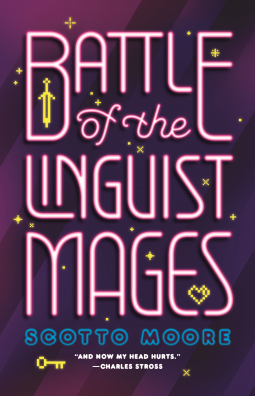 Battle of the Linguist Mages, by Scotto Moore (Tordotcom)
Battle of the Linguist Mages, by Scotto Moore (Tordotcom)This is a deliciously psychedelic romp through the virtual worlds of gamers, linguists, philosophers, cultists, and political power players. Isobel is the Queen of Sparkle Dungeon, a medieval rave-themed VR game. Her prowess makes her an ideal candidate to learn the secrets of "power morphemes"—dense units of meaning that can warp reality when skillfully pronounced. As she masters level after level of power morphemes, she realizes the driving force behind them—and her beloved game—is a shadowy faction led by the Governor of California, bent on developing the arcane art of combat linguistics to create a totalitarian empire. This faction is out to recruit Isobel, but so is the resistance movement of spellcasting anarchists. Unfortunately for everyone, the faction has attracted much bigger and weirder enemies than the resistance, emerging from dark and vicious dimensions of reality.
The story is jam-packed with ideas, action, and just plain fun. I mean, really, combat linguistics? I loved the characters, even the evil, scheming governor. I’m not a gamer, although many of my friends are, so I’m sure some of the hilarious Easter eggs and in-jokes went by me. If there’s a fault in the book, that is its length. There’s a limit to how many didn’t-see-it-coming twists one storyline can sustain and even whimsy falters after so many pages. Still, I enjoyed the linguistic mages enough to look forward with anticipation to Moore’s next book.
December 16, 2022
Short Book Reviews: Gideon Sable Returns!
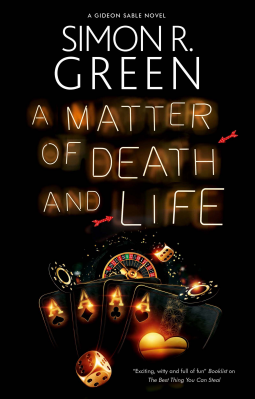
A Matter of Death and Life, by Simon R. Green (Severn House)
Master thief, rogue, and con artist extraordinaire Gideon Sable is back for another supernatural heist, this time stealing an artifact rumored to grant immortality from a Las Vegas casino. In the process, he’ll pay off a very big favor and piss off his enemies. To do this, he pulls together his old crew, including his now-girlfriend, Annie Anybody, the woman who changes her persona as easily as her clothes and who can make electronics fall in love with her; The Damned, who wears invincible armor made of the halos of angels; and Johnny the Wild Card, who has walked the edge of madness so closely he’s on nodding terms with reality at the best of times. Joining them is predictably unreliable Switch It Sally, whose special talent is exchanging objects from a distance, instantaneously and invisibly. But the casino’s owners are definitely Bad Guys, it’s guarded by supernatural goons, and in this universe, nothing is ever as it seems.
I first encountered Gideon and his crew in The Best Thing You Can Steal, and this book is a worthy sequel. Green handles character, tension, and gorgeous if dark imagery so beautifully, his work is a joy to read. Here’s a taste:
“I finally came to a quiet cul-de-sac where the street lamps were remainders of a bygone age. All black iron and ornate stylings their light was so hazy that shadows formed dark pools between the lamps, like sinkholes in the world. The buildings were just dark shapes, with no lights at any of the windows, slumped together like drowsing animals, waiting for their prey to come within reach. Ample warning that this was not an area to be entered lightly, because the phrase ‘urban jungle’ isn’t always a metaphor.
“One photo showed a city where every building had been carved from a single piece of bone, and insects the size of people, or perhaps people who moved like insects, crawled up the outsides of the buildings. Another photo showed a flock of white whales, flying over an endless desert like living dirigibles. In a New York where all the skyscrapers were wrapped in ivy, lizards in smart city suits walked briskly through the financial district. Pterodactyls flapped around a broken Eiffel Tower…”
December 12, 2022
Community and Virtual Connection
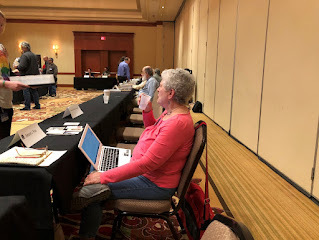 Autographing at 2019 Nebula Award weekendIt’s been several years since I’ve gathered with fans and other writers in person. I used to attend local
Autographing at 2019 Nebula Award weekendIt’s been several years since I’ve gathered with fans and other writers in person. I used to attend localscience fiction conventions regularly, but the last one was FogCon (Walnut Creek CA) in February 2020. I find it amusing that my last haircut was in March 2020, although one is not necessarily causative of the other. I attended book signings at local stores and gave presentations at our local branch library. I also organized a monthly lunch and support group with a group of local writers. Needless to say, all these came to a screeching halt with the pandemic, and while some have ventured into in-person conventions, I have not done that yet. I’m in my mid-70s, which in itself increases my risk of serious disease or death, but I feel strongly that no one should ever feel pressured to defend wearing a mask or justify staying away from indoor gatherings. (In my case, there’s the personal risk, plus that my younger daughter spent the final year of her medical residency in Family Medicine taking care of desperately ill and dying Covid patients — this was before vaccines were available — and she is fiercely protective of me.)
All of which leads to social isolation, especially from my peer group, other genre writers. Video conferencing has helped ease the loneliness, although nothing entirely takes the place of hugs and shared adventures. My first forays included skyping my husband every night when I took care of my best friend in another state during the last weeks of her life; we finally went to phone calls because the video kept pixelating, the signal was so poor. Then my daughter attended medical school on the other side of the country and we video chatted regularly until her last year, when she was in clinic most of the time.
When the pandemic hit, I was fairly comfortable with many things video, and I started attending conventions remotely, for example, The Nebula Awards weekend, InkersCon, and various panels at other conventions. Hang-outs, mini-conventions, and themed chat sessions (such as those hosted by Lemon Friday) have proven to be great ways to meet new writers and learn much cool new stuff. I love being able to watch recorded events so I wasn’t forced to choose between two panels I wanted to attend. And to re-watch things at my own convenience. I even moderated a panel, although the inconsistency of my internet connection (due to living in a remote, mountainous place) knocked me offline for a full 10 minutes. Thankfully, the panelists carried on in fine fashion and no one seemed the worse for my absence!
Besides virtual conventions (and telemedicine doctor visits), I’ve participated in other ways of networking through video chats. Three other professional women sf/f writers and I formed a career support group, and we meet a couple of times a month. We’re on 2 coasts and 2 continents, so with the exception of the time difference, geographical proximity isn’t an issue. A colleague and I have bi-weekly writing dates, which have worked out splendidly for both of us. We chat for a few minutes about what we intend to work on, then we leave the chat window open while we each dive into our respective projects. The improvement in focus and accountability is extremely helpful. SFWA (and, I assume, other groups) host regular Writing Dates and I’ve attended a few of these. The structure of the sessions I participated in didn’t work for me; there’s a break at 45 minutes and then chat in breakout room, interrupting my concentration. My colleague and I picked a length for our sessions that allows us to go deep into our work without taking up all day. We’ve both been known to take a short break at the end of our session and then return. Having only 2 participants means we can adjust to our individual needs.
I still miss seeing my friends in person, strolling through the dealers rooms at conventions, autographing books for my readers, and all the fun of masquerades and other fan-run performances, and I’m looking forward to doing all that again. But modern internet technology plus our own creativity has produced a bevy of alternative ways to get (or stay!) connected. I hope that when or if the pandemic eases and we’re back to “real life,” we’ll keep these discoveries, too!
December 10, 2022
Today's Moment of Beautiful Music
Serene, gorgeous piano music for a rain morning.



